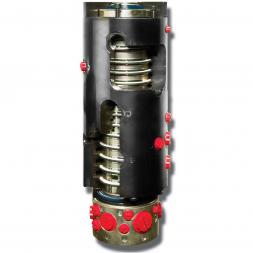Rotary Manifolds - Multiple Rotation Integrated Circuits
Key Features
- 360° Continuous Rotation
- Multiple Rotations
- Mechanical Structure
- Superior Sealing
- Up to 20 Stations
- Up to 7500 PSI
Allows
- Oil
- Water
- Gases
- Electronics
Parker Rotary Manifolds are used in applications where multiple rotations of a mechanical structure are required. A hydraulic rotary manifold’s primary function is to allow oil, water, gases and electronics to pass through it while allowing a 360 degree continuous rotation. Depending on the application, these manifolds are manufactured in various configurations and sizes containing up to 20 stations and can operate at pressures as high as 7,500 psi.
Parker’s Rotary Manifolds are designed to provide leak-free performance in the most rigorous applications. Parker’s unique step shaft design, proprietary seal design and non-welded barrel ensure the user of extensive service life while providing a compact and easy to fi t solution. Parker’s Application Engineers work with our customers to provide proper function and fi t as well as optimally designed mounting and hydraulic fittings.
Comoso/Parker collaborate closely with the customer to design the rotary manifold to meet the specific requirements of each application. In addition, Comoso and Parker’s Application Engineering team will also supply design support for application mounting and bracketry to ensure the proper installation of your custom designed manifold.
Considerations when applying a Rotary Manifold:
- How many passes/stages/circuits are needed to incorporate all necessary elements within application?
- What are the functions of each circuit? i.e. Steering, track drive, cooling system, etc…
- What is the pressure within each circuit?
- What are the fl ow requirements?
- What fl uid will be used within the application? (i.e. Hydraulic oil, gas, diesel, etc…)
- What application is the rotary manifold needed for and/or what is the intended function?
- What is the mounting confi guration?
- Are there size constraints?
- What is the port orientation and confi guration?
- What are the port connections (i.e. SAE, BSPP, ISO, etc…)
- What is the RPM of the rotary?

